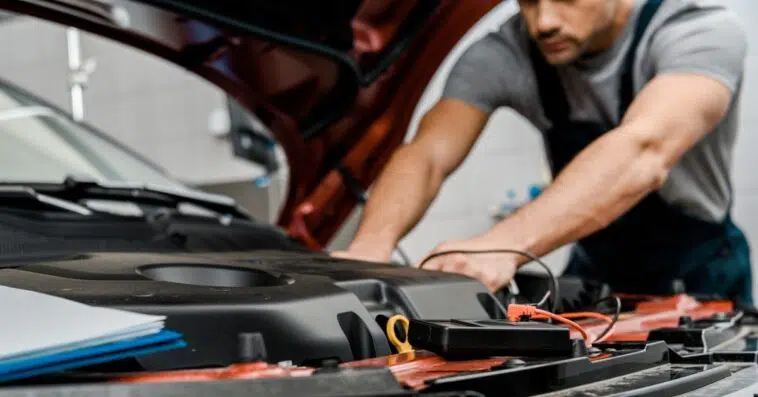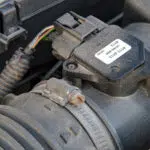Did you install a new battery in your vehicle and want to maximize its longevity? If you have your fair share of miles behind a steering wheel, then you may be familiar with starting issues, or even worse, times when the battery does not charge properly.
The culprit of the issue is incorrect or no grounding at all. If you are looking for how to properly ground a car battery then you can ground a battery by:
- Using a high-quality ground cable
- Connecting the red connector to the positive terminal
- Connecting the black connector to the negative terminal of the battery
- Connect the other end of the wire to an unpainted metal part of the car
This way, you can ensure that the battery will be properly connected, and any excess charges will be disposed of safely.
TABLE OF CONTENTS
What Is The Importance Of Grounding?
Charge holders, like batteries, have been designed to deliver huge pulses of electricity. Although the chance is rare, there is a possibility that the current can travel to other parts of the vehicle and the engine. This electricity is hazardous for the engine, but if someone touches the live part, they risk being electrocuted.
There is even a chance of the battery exploding, but that has a slim to none chance of happening. Grounding a battery gives the charge a safe path to escape, so it does not build up in places where it can be lethal.
2 Ways To Ground A Car Battery
Grounding a car battery is not a difficult task. Although I did outline the steps above, we will be going into a little more detail, so you can know how everything works. There are two ways of grounding a car battery:
- Jumper Cable Grounding
- Grounding Using A Steel Rebar
I will be detailing the steps for both of them, so you can choose which one is more suitable for you.
1. Jumper Cable Grounding
This type of grounding is quite similar to the process of jumpstarting a battery. If you are a vehicle owner, then there is a good chance that you are already familiar with the process.
But, if you are not, then these steps will surely help you:
- Choose a good-quality ground cable. You don’t want to save some bucks as improper grounding can cause severe damage to you and the engine. After buying one, you should connect the red connector to the positive terminal of the dead battery. If you don’t know the difference, then the red one is the positive one.
- This next step is simple and quick. All you need to do is grab the other end of the red wire and attach the connector to the live battery’s positive terminal. This establishes the first connection between the two batteries.
- The following step is a hybrid of the previous two. You need to take the black wire and connect one end of it to the live battery negative terminal. It is the black-colored one, and there are only two terminals, so finding the second one is easy.
- The other end of the black wire is to be connected with a metal part of the vehicle. It must be remembered that the part must be unpainted, as it reduces its conductivity. If you cannot find one, you can attach the wire to a bolt-on engine or a nut. They are usually unpainted and should be easy to spot.
These are the simple steps to connect two batteries while grounding them both. Again, it is almost similar to the steps of jumpstarting a battery.
2. Grounding Using A Steel Rebar
If you have a metal rod or something similar available for use, then you are lucky. Although the job of grounding a battery is very easy, it becomes even easier when you use steel rebar.
Let’s walk through the steps of the process:
- Hammer the metal rod into the ground. Don’t insert it completely but till the point that it will not move on its own. You can try to move the rod, and the best way to check is home much movement it has. The lesser, the better.
- What you did in the first step is that you grounded the metal rod. You should take one battery cable, attach it to the battery and connect the other end to the rebar. Before you ask, the cable that needs to be connected is the black, i.e., the negative terminal one.
- Finally, you have to connect the red terminal of the dead battery to the live one. This will complete the circuit, giving you proper current flow with excellent grounding.
Which Grounding Method Is Preferred?
Although both ways of grounding yield the same results, I would still prefer the first one. You don’t need to find a rebar, and everything can be done directly without any additional hardware, except for the cables.
There is no difference in the grounding process, except that in the first method, the bolt is the one connecting, helping you distribute the charge, while in the latter, you are connected to the ground directly.
Failure To Ground A Battery Properly
The instances of people not being able to ground a battery properly are quite a few. This is since this should be taught widely, as improper grounding can have adverse effects.
If the grounding process was not done right, then the first thing that you will notice is that the car may have trouble starting.
The ignition system needs the proper jolt of electricity, and if not, you will certainly run into problems. You don’t want to run into the problem of your vehicle not starting during an emergency.
The battery will also not charge properly when there is not a grounding circuit present.
This means that you may not start the vehicle at all, or the electronics may stop working at any time. If you rely on GPS while traveling, you don’t want to lose the navigation system.
Number Of Grounding Cables
It is a common misconception that grounding requires more than one cable. The reality is the complete opposite of that. You don’t need many cables as one is more than enough to disperse all the extra charge.
But the cable that has to be used must be solid. I did state before that a cheap cable may cause issues for you. It can be harmful to you to get a low-quality one.
Testing A Ground Connection
Testing a ground connection is essential to ensure that there is a proper connection. Apart from the visual check, another technical way is to get a multimeter for the job to ensure that there is a connection.
You can also use a ground checker, but a multimeter is preferred as it can be used for other household jobs.
Identifying The Ground Cable
This, right here, is a simple task. All you need to do is check for a wire leaving the negative terminal of the battery.
Normally, it is a thick and black wire and is hard to miss. You can follow the wire, and it will be connected to the chassis of the vehicles. This completes the ground circuit.
Identifying A Poor Ground Connection
I have good news and bad news for you in this regard. The good news is that incorrect grounding is easy to spot. It is not a problem that slowly increases over time.
So, if the issue emerges in your engine, then you can get it fixed as soon as possible. The bad news is that the damage if left untreated can be pretty severe.
Some things that you can observe are:
- Flickering lights
- Dead battery
- Low voltage
- Damage to the ground cable
As the engine can get extremely hot, it is safe to assume that the grounding cable could get damaged. If it is, then its conductivity takes a hit.
All of the above symptoms usually happen in tandem with incorrect grounding, so you should check and fix the issue as soon as possible.
Terminal Order
There is even a small order you have to follow when you disconnect the cables of a battery.
When disconnecting, you must remove the negative connection first and then the positive.
When connecting, the process is the complete opposite of that. The positive will come before the negative.
Length Of The Cable
It is always advised and is common knowledge that the length of the cable must be as small as possible. This ensures a proper current flow.
Plus, you don’t need a long wire to ground the battery using the engine block. It is made of iron, which is an excellent conductor.
Conclusion
Learning how to properly ground a car battery should be something that is taught on a larger scale.
It is an important part of the electrical system and eliminates the risk of damaging a vehicle’s electronics or even a battery exploding. You don’t want the latter to happen.
This article is a tutorial by itself. That is why I saw it fit not to include a FAQ at the end.
I hope that you may have realized the importance of grounding your battery. If you have, then I suggest that you check your vehicle as soon as possible.




